Not Your Mother’s Stability Running Shoes
Womens_Running and Yahoo may earn affiliate commissions on some items promoted through links in the article below. This article originally appeared on Womens Running
Not long ago, you could easily identify a stability running shoe by its firmer, darker-colored foam underneath the arch side of the foot. On the run, you could tell it was a stability shoe by its stiff, heavy, and controlling ride. Not anymore.
Today's stability running shoes are well-cushioned, smooth riding, and free from clunky controlling devices--so much so that they are equally comfortable for neutral runners as for those needing extra support. In place of the stiff medial post--designed to block overpronation, the excessive inward rotation of the rearfoot--designers are using a variety of less intrusive, more integrated strategies to help runners whose feet stray inward or outward on the run.
It's about time, given that the science showing that excessive pronation is rarely problematic and that traditional motion-control methods do little to control excessive motion has been around since the 1990s. But change has come slowly to an industry and a population steeped in the pronation paradigm. While the market for stability running shoes, and the number of stable shoe models, have decreased substantially in the past decade, only recently have we started to see major shifts in how a stability shoe looks and rides.
"Stability is a function of so many features, such as sole geometry, stack height, midsole hardness, outsole, upper materials and how they are structured--not just medial posting," says Kurt Stockbridge, product development vice president at Skechers. "Each of these levers can be pushed and pulled to make a great stability shoe without it having to look like what we typically picture."
The New Wave of Stability Running Shoes
New stability running shoe designs embrace the reality that every aspect of the shoe affects the ride, and the new strategies recognize and work to reduce the instability caused by the shoe itself as it distances the foot from the ground. Toward this end, all have wide bases to spread the support and keep the foot from rolling off the platform, and all ease the transition from landing to toe-off, ensuring that the shoe doesn't create levers that torque the foot out of its preferred motion path. But each employs a variety of new features to achieve that smooth, stable support.
Here are seven new shoes breaking the mold and ushering in a more comfortable, more versatile world of stability.
How We Tested Innovative Stability Running Shoes
After running in dozens of new shoe models this year, I selected the pairs with innovative, unique, and effective stability features and did multiple runs in each of them at a variety of distances and paces.
About me: I've been a runner since the late '70s and a running magazine editor and shoe reviewer since 2000. I'm the author of Your Best Stride, and Run Strong, Stay Hungry. Once a 2:46 marathoner regularly doing 50+ mile weeks, injuries and age have reduced my volume by about half and slowed my easy training pace. Those injuries have also given me rather complicated stability requirements. My left foot is high-arched and neutral, while my right foot has been weakened and appreciates support. Too much support, however, makes my right knee hurt, as it has to pronate inward to off-load stress from a chronic condition. All of which makes me well suited to test these new, less-prescriptive stability strategies which promise to adapt to the level of support needed.
Asics Kayano 30 | $160
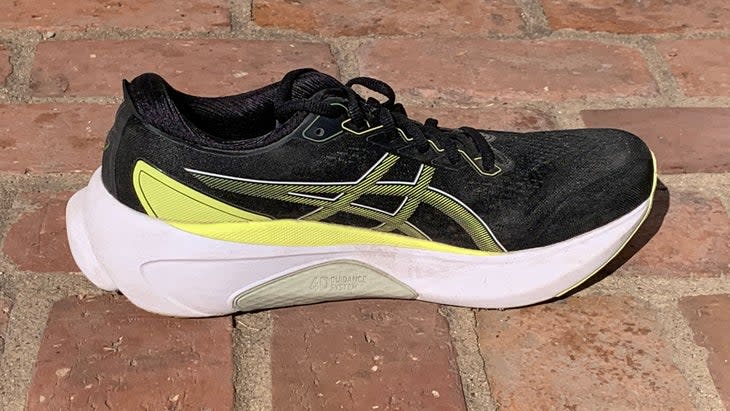
Innovative Stability Feature: Soft, bouncy medial post
Weight: 9.2 oz (women's); 10.6 oz (men's)
Stack Height: 40--30mm (men's); 39-29 (women's)
Drop: 10mm
The all-new 30th anniversary Kayano is the most radical example of change in stability strategies. For three decades the Kayano has stood as a pinnacle long-run stability shoe, bolstered by a substantial medial post and a plastic midfoot support bridge. The new Kayano replaces these firm, controlling devices with clever geometry and new, unobtrusive foot-guidance strategies, creating what Asics is calling a "4D Guidance System" (the fourth dimension being time, which leads to fatigue and causes more runners to need guidance for their strides).
"The system is everything working together; not one aspect but everything in concert that is helping aid in stability," says Chad Mullavey, global product line manager at Asics. "Knowing that running is not a single-plane type motion but a three-dimensional interaction with the ground, we looked at how to address, slow, and accelerate certain aspects to ideally reduce the amount of forces that are translated into the runner's body."
The new Kayano's stability strategy includes multiple tweaks to the midsole geometry: The platform is wide from heel to toe, and flares even wider at the base under the forefoot. The lateral side of the heel is sculpted out to let it compress more, smoothing and slowing the transition from heel contact to mid-stance. A corresponding bulge on the medial side reduces compression, plus the midsole wraps up along the side of the heel to cradle and subtly support.
Most unique, however, is a pod of softer, lower-density but highly responsive foam under the arch where previous versions had a firm medial post. "This pod does two different things," Mullavey says. "It's softer, so as you load at midstance, it compresses and increases the effective midfoot width, and it's higher rebounding than the main carrier. So as you're coming up and out of midstance, it helps to encourage you to resupinate to an effective position for each subsequent footstrike."
The thinking behind this new insert stems from research that shows it's not the degree of pronation that predisposes a runner to injury but the amount of time spent at peak pronation. So instead of trying to block the foot's rotation, the shoe simply returns it quickly to a neutral position. On the run, I didn't notice the rebound under the arch, but I did seem to sense its effect as my foot rolled onto the forefoot feeling upright, centered, and ready for a stable push-off.
Overall, the shoe's width made the greatest impression, both in terms of luxurious space-- without feeling sloppy--and the security of landing on and rolling over the generous platform. I didn't even feel high off the ground, despite the 40mm stack height, given the lack of any tippiness. My only complaint was that the heel flared a bit much on the lateral side and seemed to torque my foot inward a little on landing when I'd heel strike heavily. (Mullavey says they're increasing the bevel on the next version.)
The goal of the redesign, Mullavey says, was "to guide the foot but not overcorrect, simplifying and reducing components that were a stiffening element, knowing that comfort and stability don't have to be mutually exclusive." My testing convinced me they succeeded. The ride, though not particularly fast or responsive, is smooth and cushy with no hint of stiff control, yet my asymmetrical feet both felt cared for and supported--especially on longer runs when I started to tire.
Saucony Tempus | $160
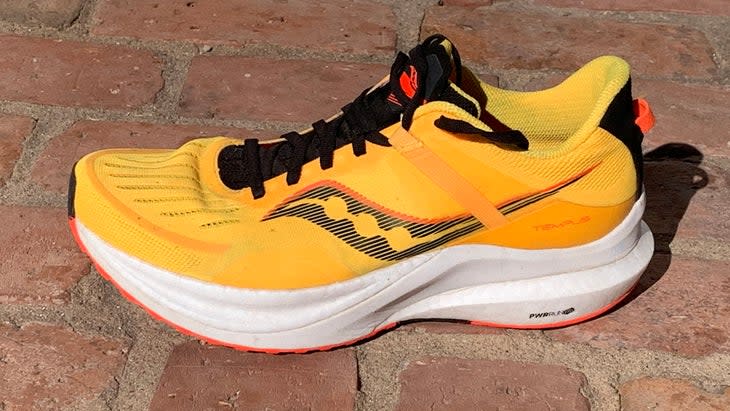
Innovative Stability Feature: Over-under frame
Weight: 7.9 oz (women's); 8.9 oz (men's)
Stack Height: 36.5-28.5 mm
Drop: 8mm
The Tempus lies at the sharp end of the stability spectrum, delivering a lively ride that made me feel nimble, bouncy, and fast--yet still providing foot guidance and support. The shoe's secret lies in its midsole, which features industry-leading, ultralight, high-cushioning, and maximum-rebounding--but unstable--Pebax foam at its core, surrounded by a denser, more supportive EVA frame.
The idea of using a firmer frame to control a softer foam's squish is not new or unique. Most models with frames, however, surround the bottom of the full shoe with firmer material. While this provides a stable stance, it makes landings harsher and can accelerate the foot's movement as it impacts the edge of the sole and rotates inward. The Tempus, however, employs a unique over-under frame that sits atop the soft Pebax in the heel, bridges the full midsole height under the arch, then dives under the Pebax in the forefoot and runs along the bottom edges up to the toe.
The magic of this frame, Chad Holt, product line manager at Saucony explains, is that by putting the Pebax on the bottom at the heel, its softness works to reduce the instability caused by the shoe. On impact, it compresses and deforms, rounding the edge of the sole and creating a smooth, gentle transition as the foot rolls inward and forward. Meanwhile, the firmer frame that surrounds the top of the heel wraps the foot and keeps it centered on the platform. The full-height frame under the arch slows the foot's rotation and supports as needed. Up front, you feel the Pebax's cushioning and rebound directly underfoot, while the firmer foam on the bottom adds a bit of rigidity to the rocker for quick-rolling toe-offs.
On the run, not only did the Tempus provide the snappiest, most-fun ride of the group, but it also seemed best at managing my varied stability needs. The soft Pebax on the bottom of the heel let my feet stay in a natural, supinated position on landing without torquing me inward like several of the shoes with stiffer flared heels did. As my foot rolled inward, the shoe provided my more-mobile right foot almost undetectable but effective support as I transitioned over the arch to the stable toe-off, yet didn't block the pronation I needed for my knee. Meanwhile, my neutral left foot didn't feel any control or clunkiness, just the smooth, comfy, responsive Pebax underfoot.
The Tempus is narrower than other stability shoes in the heel and midfoot, but spreads out as wide as any in the forefoot. It's also low enough up front to provide the ground feel necessary for a solid, propulsive push-off, and flexible enough to allow a natural roll at any pace or stride angle. The shoe felt responsive and fast at any pace, but the subtle support was always present, and the farther I ran, the more I appreciated the shoe's guided roll and side-to-side stability.
The Tempus could make a great marathon shoe for someone who wants the pop of Pebax with some foot bolstering during the long miles, and an excellent long-run training shoe even for those who will race in a carbon-plated super shoe.
New Balance Fresh Foam X Vongo V6 | $165
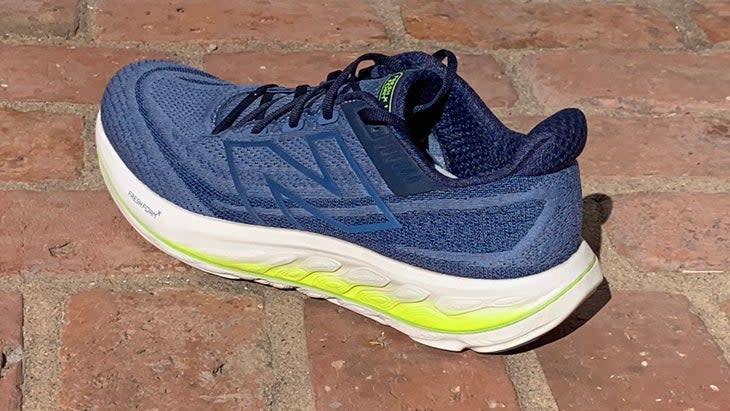
Innovative Stability Feature: Angled plate
Weight: 8.5 oz (women's); 10.6 oz (men's)
Stack Height: 38-32mm
Drop: 6mm
All of the embedded plates popular in today's running shoes function mostly to stabilize the squish and rebound of thick stacks of soft and responsive foam. While most plates, such as those found in marathon-racing super shoes, focus on directing and enhancing forward roll and push-off, some serve primarily to moderate lateral roll, like Skechers' winglet and H plates, or the midfoot wings on the plastic plate in the Saucony Endorphin Speed.
The plate in New Balance's completely remade Vongo V6 takes rotational guidance a step further. The semi-flexible EVA film is sandwiched between two foam layers (soft over firm), and angled in the heel, higher on the medial, or arch side, and lower on the lateral side. This results in more firm foam under the arch side and more soft foam on the outer, landing side. The plate also has hexagonal cutouts that reduce its rigidity on the lateral side but is solid on the medial side. Both elements help create a soft, smooth landing and slow the inward foot rotation without creating a clunky transition or compromising the shoe's cushioning.
The Vongo's plate isn't just about defining that angled wedge, however, says Paul Zielinski, senior global product manager at New Balance. Research in their lab revealed that midsole foams stretch under force when the foot was pronating far or at high velocity. The plate, Zielinski says, "Allows for the foam to be a little more structured, and not stretch or shear as much. Working in combination with the two different midsole hardness foams, this system is helping stabilize the structure of the platform so the foot feels guided all the way from heel to toe."
Contributing to that full-foot roll, the sole has also changed, moving away from traditional horizontal flex grooves to a more vertical, back-to-front pattern. Zielinski says this new sole--paired with the plate, additional midsole foam under the forefoot due to a lower heel-toe drop, and a slight rocker profile--is designed to provide a smooth rolling transition from midfoot to toe-off.
On my foot, the plate and dual-density foam provided the strongest rotational support and traditional medial stability of any shoe in this group. While the midsole was soft underfoot, and delivered a cushioned and smooth ride, my foot pronated very little. The control didn't irritate my neutral left foot, and it felt comfortable and comforting to my weaker right foot, but, fairly quickly, I could feel the bones in my right knee-that-must-pronate start to rub as it wasn't tracking inward at all.
I also found the shoe ran smoother when I upped my cadence and got my balance over the forefoot where I could more effectively roll over and push off the thick, somewhat springy toe. Zielinski says it isn't designed as an up-tempo shoe, but for my stride, it isn't as comfortable at a slow recovery jog as other shoes in this category but rides snappier and smoother at a steady rhythm.
After a rather traditional, clunky, heavily posted V5 of the Vongo, I applaud New Balance for the innovative redesign of the V6. "Sometimes it feels like stability runners are getting a compromised shoe compared to their neutral counterparts," says Zielinski. "We wanted to bring stability runners into the space of modern neutral foams that provide amazing energy return, bounce, and comfort."
With its strong medial support, the Vongo V6 is not quite as versatile for neutral runners as some other options in this guide, but it's a solid choice for those who want to slow pronation velocity in a shoe that delivers a smooth, comfortable transition from landing to toe-off.
Hoka Gaviota 5 | $175
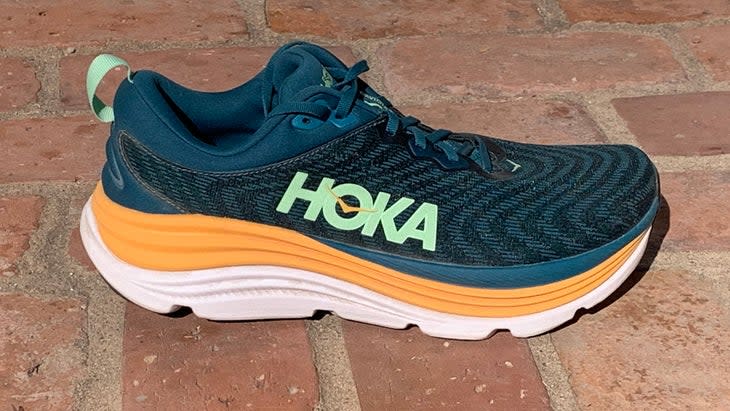
Innovative Stability Feature: H-Frame
Weight: 9.1 oz (women's); 10.9 oz (men's)
Stack Height: 34-28mm (women's); 36-30mm (men's)
Drop: 6mm
Despite their high stack heights, Hoka's shoes have always had an inherent stability from their wide platform and cockpit-like cradle surrounding the heel as it sits down into the top of the midsole. For years their stability models have also used a "J-frame" to provide more rotational control. This firmer-density foam reinforced the midsole at the full height of the arch side of the shoe and wrapped around to the lateral side on the bottom edge.
The redesigned Gaviota 5 retains the wide geometry and raised sidewalls, but swaps the J-frame for a new H-frame. This layer of less-dense foam lies on top of the midsole and surrounds the perimeter of the shoe with a connecting piece across the middle--forming a figure eight shape. As the foot sinks into this layer, it nests deeper in the foot frame created by the sidewalls of the more stable, but still cushioned, bottom layer. Hoka says the H-Frame allows them to use softer foams than before to deliver inherent stability while enhancing cushioning, especially close to the foot.
On the run, the frame was all but invisible, its presence only noted by a feeling of centeredness as I sunk into the forgiving footbed. It is enough, however, combined with the ample width and secure hold of the flexible-but-not-stretchy creel jacquard upper, to keep the well-cushioned shoe from feeling at all tippy. While it doesn't make any pretense of reducing inward rotation--which may not work as well as other options for those who roll excessively--the full-foot stability kept both of my feet and knees feeling safely coddled no matter how long I ran.
Nike InfinityRN 4 | $160
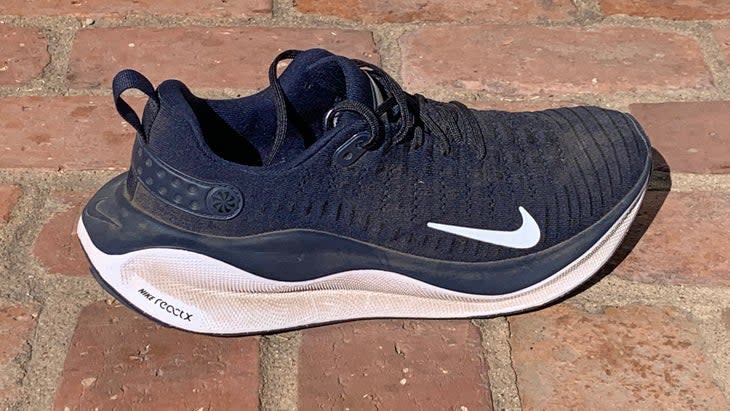
Innovative Stability Feature: Grooved lateral sidewall
Weight: 9.9 oz (women's); 12.5 oz (men's)
Stack Height: 39-30mm
Drop: 9mm
Nike's InfinityRN 4 relies on simple strategies to provide stability: a wide platform flared even wider under the forefoot, sidewalls surrounding the heel up to midfoot, and, most uniquely, a deep groove running the length of the lateral sidewall. That groove, which lets the base of the sole collapse upon landing, is designed to eliminate excess inward torque and, I found, creates a super-smooth transition from touchdown to midstance.
Despite lacking any more aggressive control features--this version even lost the rigid horseshoe-shaped heel clip of previous models--the shoe delivers a stable ride, primarily due to the cushioned, responsive, but not overly squishy ReactX midsole, which catches, supports, and centers the foot. The foam is thicker than ever (5mm more in the heel, 4mm more in the forefoot), and bouncier, delivering a luxurious yet sporty ride--think Lexus Sports Sedan rather than Cadillac Town Car. The early rocker encourages a quick toe roll and works together with the foam's rebound to keep strides from wallowing in the thick platform, but the shoe's weight keeps it from being very speedy.
A stretchy knit upper contributes to the plush feel, yet, surprisingly, doesn't make the fit sloppy, thanks to some thicker-knit ribs around the instep and a gusseted tongue. One complaint: While the forefoot is amply wide around the ball of the foot, it narrows sharply toward the toe, keeping my big toe from splaying and fully engaging.
The InfinityRN 4 doesn't control rotation as strongly as other stability options, but it delivers a unique ride that is simultaneously cushy, stable, responsive, and oh-so-smooth, and will work for any who wants a plush shoe that isn't sloppy or tippy.
Brooks Adrenaline GTS 23 | $140
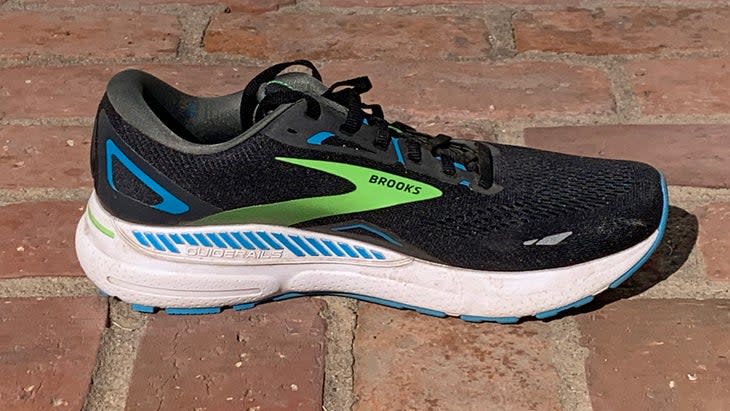
Innovative Stability Feature: Guide rails
Weight: 9.1 oz (women's); 10.1 oz (men's)
Stack Height: 35.5-23.5mm
Drop: 12mm
The Adrenaline GTS 23's GuideRails are not new this year, but are worth highlighting because Brooks was a leader in adopting innovative stability strategies. The brand dropped the medial post on the Adrenaline, its signature stability model, in 2019 and has since created a more stable "GTS" option for a variety of models, from the light, low, responsive Hyperion to the smooth-riding, highly cushioned Glycerin.
All employ GuideRails, strips of slightly firmer foam on top of the midsole that run along the perimeter of the heel up to the middle of the arch and deliver lighter, more cushioned, and smoother support than a full post. Plus, they are less prescriptive, engaging the foot only when needed, thus working for a wider range of runners. "It doesn't go all the way down to the ground, so it gives the shoe a little bit of play," says Jon Teipen, principal footwear product line manager at Brooks. "It's not going to be a firm block on the medial side of the shoe. The more you evert [roll inward], the more the GuideRail will push back on you."
The updated midsole foam on this year's Adrenaline is lighter and softer, and the engineered mesh upper provides a secure and comfortable fit, hugging the foot while staying flexible. The 12-millimeter drop, flexible forefoot, and palpable support under the arch give the Adrenaline 23 the most traditional stable-shoe feel of this group. Still, unlike the stiff, clunky Adrenalines of old, I found the ride smooth and un-controlling, similar to that of the neutral Brooks Ghost 15, with a bit of supportive rearfoot cradling. Both the cushioning and support seem to shine most when landing solidly on my heel and rolling through the stride.
Altra Paradigm 7 | $170
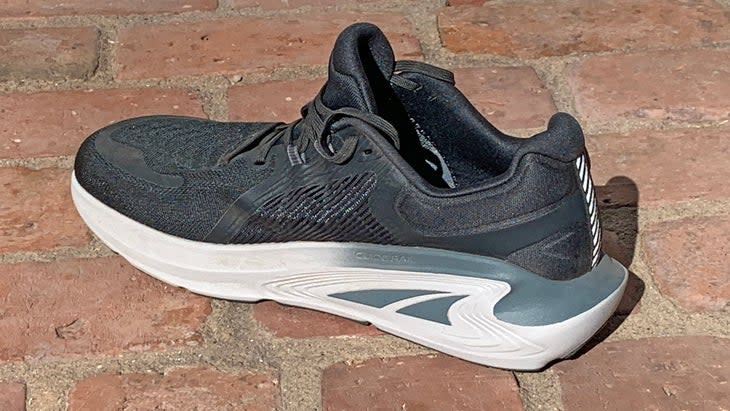
Innovative Stability Feature: Footshaped last, balanced stance
Weight: 9.5 oz (women's); 11.8 oz (men's)
Stack Height: 31mm heel to toe
Drop: 0mm
Altra's shoes achieve stability through a balanced, zero-drop platform combined with a wide toe box that lets your foot spread out and supports your stance naturally. This has allowed the brand to use soft, bouncy foams, rather than stiff platforms and rigid control devices--long before other companies began playing with geometry. Their cushioned stability model, the Paradigm, has also had guide rails since 2014, but, unlike Brooks's version, Altra's elevated rim, higher on the arch side, is the same density as the rest of the midsole, creating a cradling effect that gently supports without any controlling pressure.
The soft foam lets the forefoot sink in, reducing the stress of adapting to zero drop, and Altra co-founder Brain Beckstaid has found that it works for just about any runner. "You can put a neutral runner in it, and they are going to love it, and yet it is nice for the heavier pronator," he says. New this year, a wide option will accommodate those with high-volume feet as well.
The midsole, 31 millimeters of Altra's lightest and most responsive foam, sinks in and contours around my foot before firming up and bouncing back, providing a unique combination of cushion, ground feel, and lively responsiveness. Plus, the ride is stable, thanks mostly to the foot-shaped last, which is not only wide enough to let my toes splay but flares underneath the big toe, allowing it to fully engage and support my stance like it would if running barefoot.
That shape, the airy, flexible upper with internal straps surrounding the instep, and the moderate stack of soft, bouncy foam make the Paradigm the most comfortable shoe of this group for my foot. That comfort persisted on the run even when going long, with the shoe staying out of the way and providing a stable platform with subtle support only where needed. The ride was smooth and snappy, feeling lively at all but the fastest paces, and seemed to keep my stride springy and quick.
For exclusive access to all of our fitness, gear, adventure, and travel stories, plus discounts on trips, events, and gear, sign up for Outside+ today.

